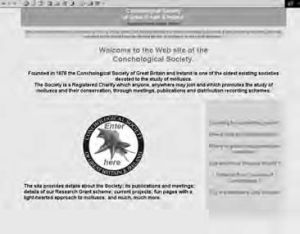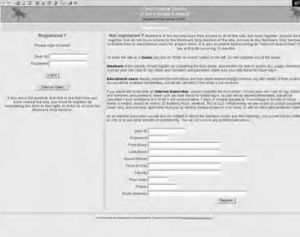21st April 2021 - Please note this article is from 2005 and the 'Internet Subscribers' functionality of the website has been discontinued.Introduction The Society’s website (http://www.conchsoc.org) has been recently redesigned and updated. A pilot scheme for Internet Subscribers has been introduced (see the section below). The site is designed to help you find information easily and to keep up to date between issues of Mollusc World. It now incorporates a Members Only Section. This includes Help with Identification, which at present covers common garden molluscs and the Vertiginidae. We hope to expand it to cover other groups or families as soon as keys and suitable images are available. We have also included diagrams and glossaries of shell terms. Also included is a Discussion Forum which enables you to take part in informal discussions with other members, whether on a technical subject, or as a request for assistance, or on any other matter, without involving non-members. You can start a topic, or post a reply to someone else's topic, or just browse.This forum is additional to the facilities offered by conchology-uk@smartgroups.com . A limited number of pages from previous issues from Mollusc World and Journal of Conchology are included in the Members Only Section. These are there to show Internet Subscribers the type of article that is available, and just what they are missing by not being full members. Online recording forms are now available for use in connection with the current projects. We expect to extend our recording activities, and online recording forms will be available for these in due course. Please pass comments about the site to webmaster@conchsoc.org who will be pleased to hear from you. Without feedback we will not know what you would like to see included. Using the site for the first time. It may be helpful to have this article handy when you first visit the website. The first page gives brief details of the history of the Society; its purposes; and what is contained within the site. By clicking on the central logo where it says "Enter here", you reach the second page. This is the Registration Page, which is necessary to prevent unregistered users accessing the Members Only Section. Anyone may enter as a Guest, but a Guest cannot reach the Members Only Section. To enter as a Guest, click the Guest button in the left hand panel and do not fill in any forms. If it is the first time of using the site, and you are a Member, please complete the form towards the bottom of the right hand side. This requires personal details, but if your telephone number is ex-directory and/or you do not wish to disclose it, please enter zeros in the format 00000 000000. The box has to be completed with numbers in order to work. Your email address has to be valid, otherwise you will be unable to gain access to the Members Only Section, and also the program will be unable to email you with confirmation of your registered User ID and Password for future reference. Subsequent visits only require you to enter your User ID and Password in the spaces on the left hand side. Having completed that, you are into the main site; in fact, probably quicker than it took you to read this far. Internet Subscribers. Council has decided to introduce a pilot scheme for Internet Subscribers, who may access all website pages, but do not receive paper copies of the Members' Guide, Journal or 'Mollusc World'. Neither may they vote nor hold office, although they are entitled to attend both indoor and field meetings. The cost of an Internet Subscription is £10 a year and it is hoped this will encourage people (particularly beginners and young people) to start the study of conchology, and go on to become full members in due course. We are offering, as part of the pilot scheme, the opportunity for registered educational users to email the Membership Secretary with details of their proposed project, and if accepted, their £10 fee will be waived for the year. Navigation. Navigation is straightforward. The top horizontal frame includes the Society Aporrhais shell logos and title. Whilst navigating your way around the site you may return to the Home Page at any time from any page by clicking on either of these Aporrhais logos. Below the title and logos are a series of six links, each going to either another main section (e.g. Fun Section; Members Section; News Section) or to an important document (e.g. Health & Safety Policy; Privacy Policy) or to Links to other sites. The vertical frame to the left displays a menu that applies to the particular section you are in. At the bottom of the lefthand menu is an image of our logo. Clicking on this will also return you to the Home Page. You will notice that the background colour of all frames will change as you move from one main section to another. This is to help you navigate. As the mouse cursor hovers over the text links in either the horizontal or vertical menu, the link is highlighted. If you return to a page after you have clicked on a link, it will have changed colour, so that you know you have already been to that linked page, but will still highlight as you hover the mouse cursor over it. Again, that is just to help you navigate. Other links within the pages are shown in green and are underlined in green. These also change colour after you have visited the linked page. When you hover the mouse cursor over an image that is acting as a link, the cursor changes to a hand-shape and will usually display a short message indicating the destination or reason for the link. Viewing. The site is best viewed at a screen resolution of 1024 x 768 pixels, the figure at which most modern laptops and PCs are set when purchased. Older models are often set at 800 x 600 pixels. If the resolution is lower than 1024 x 768, although the text is larger, you will need to scroll down in order to read the longer pages. If you have the resolution much higher, the text becomes smaller and more difficult to read at the usual viewing distance. For those using Microsoft Windows who would like to check or change the resolution, right-click on a blank space on the Desktop and choose Properties from the shortcut menu; then click on the as your browser, you will find that by clicking on View, and choosing Full Screen, many pages will not require much, if any, scrolling. You can soon revert to your normal screen size by clicking on the Restore button at the top right of the screen. Many other browsers have a similar facility. Anticipated Future Use of the Website We intend to expand the website in order to provide visitors to the site, especially beginners and young people, with the tools and background information they need to take up the study of molluscs and their shells. With this in mind, we would like to: • Extend the Help with Identification section by including other groups and families, e.g. Planorbidae, Lymnaeidae, Zonitidae, Cockles, Chitons, etc. For this we will require help from you, the members, to write the appropriate keys and to provide the images. • Re-introduce learning aids similar to the former series “Papers for Students”. • Include images of habitats typical of defined groups of species, e.g. species commonly associated with rocky shores in Britain, and provide a list of the species as a starting point for study. (Most of the images and species lists are already in place or are in the course of preparation at the time of going to press). • Provide a bibliography of useful books, not only on identification, but also on physiology and behaviour of molluscs. • Extend the recording projects. If you feel able to help in any way, or have comments about the website please contact webmaster@conchsoc.org Personal Home Page Why not use the Society's News Page as your personal Home Page? That way you will not miss any late-breaking conchological news, possible changes to indoor or field meetings, or details of the latest finds. The easiest way to do this is to navigate to the News Section, and set your browser to use the current page as your home page. With Microsoft's Internet Explorer, click on Tools in the toolbar, and choose Internet Options and then "Use current" on the General tab. With Netscape, click Edit in the toolbar, and choose Preferences, Navigator, and click "Use current page". Opera 5 and Opera 7.5 are similar; click Navigation, choose Set Home Page, and in Opera 5, click on the button labelled "Use Active" beside Global home page, or in Opera 7.5, click on the radio button beside "Set current page as home page". Other browsers have similar facilities. Even if you decide not to make it your personal home page, Bookmark it or enter it in your Favourites, so that you are able to keep up to date. Be sure to make use of the website if you have access to the Internet — the site is there for your use! |
|
Conchological Society Website
Issue
9
Page
10


